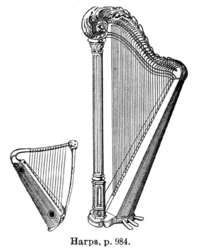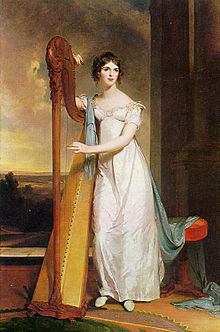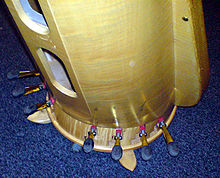- Pedal harp
-
Harp 
Classification String instrument (plucked) Playing range Related instruments The pedal harp (also known as the concert harp) is a large and technically modern harp, designed primarily for classical music and played either solo, as part of chamber ensembles, as soloist with or as a section or member in an orchestra. The pedal harp is a descendant of ancient harps.
Contents
Parts of the concert harp
Body and strings
A pedal harp typically has six and a half octaves (46 or 47 strings), weighs about 80 lb (36 kg), is approximately 6 ft (1.8 m) high, has a depth of 4 ft (1.2 m), and is 21.5 in (55 cm) wide at the bass end of the soundboard. The notes range from three octaves below middle C (or the D above that) to three and a half octaves above, usually ending on G. The tension of the strings on the sound board is roughly equal to a ton (10 kilonewtons). The lowest strings are made of copper or steel-wound nylon, the middle-lower strings of gut, and the middle to highest of nylon, or more or all gut.
The pedal harp is identifiable as a large instrument with a straight pillar for support sometimes adorned with a crown at the top, a soundboard, which is pear-shaped with an extended width at the bottom in most harps, while some mostly older pedal harps have soundboards that are straight-sided though widening toward the bottom, a mechanical action made up of over 1,400 parts attached to a harmonically curved neck, a base with seven pedals that are arranged in the following: D C B (left) and E F G A (right). The D B E G A strings are normally colored white while the C strings are colored red and the F strings are colored either black or blue. The strings are initially (before any pedals are activated) tuned to all flat pitches: that is, to the scale of C-flat major.
Pedals
Pedal harps are essentially diatonic instruments which are fitted with the double-action pedal mechanism to allow chromatic alterations and key changes: no matter how the pedals are set, the pedal harp still has only seven strings per octave. Smaller harps, often called folk, lever or Celtic harps, are equally diatonic instruments (also with seven strings per octave) and use a mechanical lever on each string which must be moved manually to obtain chromatic alterations. The only completely chromatic harp is the cross-strung harp which has twelve strings per octave, or the triple harp.
The pedal harp uses the mechanical action of pedals to change the pitches of the strings. Pedals were first used in 1697.[1] On the modern harp there are seven pedals. The pedals (in order from left to right) on the left side of the harp are D C B, and E F G A are on the right. Each pedal is attached to a rod or cable within the column of the harp, which then links to a series of moving rods within the neck. When a pedal is moved with the foot, the column rod is moved, which then moves the linkages and turns either or both of two small discs at the top of strings. The discs are studded with two pins that press against the string as they turn, shortening the vibrating length of the string. The pedal has three positions. In the top position no pins are in contact with the string and all notes are flat; thus the harp's native tuning is to the scale of C-flat major. In the middle position the top disc presses its pins against the string, resulting in a natural, giving the scale of C major if all pedals are set in the middle position. In the bottom position the second, lower disc is turned, shortening the string again to create a sharp, giving the scale of C-sharp major if all pedals are set in the bottom position. The order of the pedals is directly influenced by the order of sharps and flats. Many other scales, both diatonic and synthetic, can be obtained by adjusting the pedals differently from each other; also, many chords in traditional harmony can be obtained by adjusting pedals so that some notes are enharmonic equivalents of others, and this is central to pedal harp technique. In each position the pedal can be secured in a notch so that the foot does not have to keep holding it in the correct position, unlike piano pedals.
This mechanism is called the double-action pedal system. Double-action systems were first patented in London by Sebastien Erard in 1801 (patent number 2502) and 1802 (patent number 2595) though these never went into production. In 1807 Charles Groll was the first person to register a patent (patent number 3059) where the harp mechanism was doubled with two lines of fourchettes or forks. There is some evidence to suggest that this patent was bought by Sébastien Érard. Whether this was to stop Groll producing his instrument is unclear though Erard clearly believed it would work. He is believed to have paid between 10,000 and 30,000 red zlotys. In 1808 Erard registered a further patent (number 3170) but it wasn't until 1810, when he registered what we know of today as the double-action (patent number 3332), that he went into production. Although he never produced the mechanism registered in the 1808 patent he did licence this to other makers such as Schweiso, Grojean and Stumpff amongst others. It is worth noting that Cousineau is believed to have made to double-action harp sometime earlier than either Groll or Erard's inventions. This harp doubled Cousineau's single-action mechanism and had fourteen rather than seven pedals. Roslyn Rensch in her book "The Harp, its technique and repertoire," notes that this harp found its way into the office of Sebastien Erard. [1]
Earlier pedal harps had a single-action mechanism that allowed strings to play sharpened notes, the first of which was made in 1720 by Jacob Hochbrucker in Bavaria.[2]
Lyon & Healy, Inc. became the major manufacturer of pedal harps in America by the end of the 19th century. They improved the construction and resulting sound, in part to withstand the rigors of the American climate. These improvements inspired harpists and composers to seek new sounds and music to express its fuller resonance. This fueled a great growth in music for the harp in the 20th century, and the concert careers of many virtuosi.
Wurlitzer made harps for a few decades but ceased by the 1930s. Their harps remain collector's items. Both companies produced ornately carved and sometimes gilded harps for their clientele. The styles range from gothic to art deco. The Salzedo model harp, named for the great harpist Carlos Salzedo, was designed by the artist Witold Gordon to express his Art Deco esthetic, and has its design elements grouped in fives: five stripes of silver and five of red on the sounding board, five layers in the columns, five facets to the base, etc.
More recent harp manufacturers include Salvi Harps, Venus Harps, Camac Harps, Aoyama Harps, and some small manufacturers exist around the world.
If a harp had its strings spaced proportionately to their length, the harp would be a very long triangular shape, but by bringing them in to even spacing, the curve of the neck is produced, much the same as the curve of the piano.
The pedal harp was extremely popular in the 17th and 18th centuries. While the piano did overtake the harp in common use sometime in the 19th century, the harp continued to grow, and is now widely played in many countries.
The pedal harp is in its own class of instruments along with the other various types of harps. Lyres, lutes, guitars, violins, etc., all belong to the lyre family, in which the strings are parallel to the sounding cavity, whereas on a harp the strings emerge out of the sounding cavity. Some instruments are called harps, but belong to the lyre family. Harps have been found in ancient Sumerian ruins, thousands of years BCE. They were common to the Hebrew tribes, the Egyptians, and in Asian cultures as well. The Spanish brought harps to Latin America where they became widespread in use.
Electric harps
Lyon and Healy, Camac Harps, and other manufacturers also make electric pedal harps. The electric harp is a modified concert harp, with piezoelectric pickups at the base of each string and an amplifier. Electric harps can be a blend of electric and acoustic, with the option of using an amplifier or playing the harp just like a normal pedal harp, or can be entirely electric, lacking a soundbox and being mute without an amplifier.
References
Categories:
Wikimedia Foundation. 2010.



